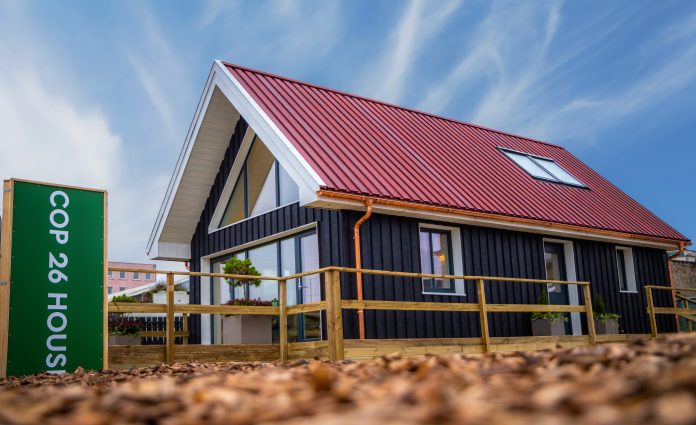Choosing the right (or wrong) building materials can be critical in dictating the whole-life carbon impact of a building. NorDan UK Ltd’s technical specification advisor Tom O’Sullivan, shares his knowledge on why reducing embodied carbon before a building is occupied is key to hitting net-zero
This summer’s extreme weather events have been a timely reminder of the reality of climate change and the contribution the construction industry must make to ensure we hit embodied carbon reduction targets.
NorDan has made a significant investment in recent years to understand better the whole-life carbon impact of our windows and doors, not least in ensuring we now have third-party verified Environmental Product Declarations, or EPDs, for the majority of our products.
Thinking about whole life carbon
According to the Green Construction Board, the built environment is responsible for around 40% of the UK’s total carbon emissions. If we’re to hit the targets set by the Paris Agreement, this must be reduced by around 7-8% per annum.
To meet this target, the industry must reduce operational and embodied carbon, which combined makes up the whole life carbon of a building.
Operational carbon is emitted whilst running a building. In contrast, embodied carbon is generated from the extraction, manufacture and assembly of a building’s materials and components, its repair, maintenance and refurbishment, and end-of-life disposal.
To date, Government policies for decarbonising buildings have focused on reducing operational carbon emissions, as these have historically been responsible for most of the total emissions over an asset’s lifetime.
While embodied carbon currently accounts for around half of the construction industry’s emissions, with the projected increase of construction initiatives over the coming decades and the increasing thermal efficiency of buildings, it’s believed that by 2050 embodied and operational carbon emissions will be the same.
It’s also important to recognise that many of the benefits of lower embodied carbon are delivered now, when we need them, as opposed to operational carbon reductions, which focus on efficiency over 60+ years.
Government response to carbon emissions in buildings
The Future Buildings Standard, which will come into force in England and Wales in 2025, aims to reduce total building carbon emissions by up to 80% by decreasing U-Values (the measure of how effective a material is an insulator), and improving energy efficiency.
Interim changes to Part L came into force in June. This which should see new homes produce 31% less operational carbon and has reduced the current allowable U-values from 1.6 W/m2K to 1.2 W/m2K, which will tighten further to 0.8W/m2K in three years’ time.
Embodied carbon has yet to be regulated in the UK, however with the reintroduction of the Part Z Private Member’s bill by Jerome Mayhew MP at Westminster and May’s Environmental Audit Committee’s report calling for mandatory whole-life carbon assessments for buildings under construction, regulation seems inevitable.
There is a groundswell of support from the industry, and many UK contractors are starting to calculate, analyse and reduce their whole-life carbon output.
However, with the World Business Council for Sustainable Development (WBCSD) estimating that these calculations are only happening in around 1% of building projects globally, it’s clear that more needs to be done now.
Resilience is key to reducing embodied carbon
A key way to reduce embodied carbon is to choose building materials that are low carbon to source and manufacture and last a long time.
This will make it harder to specify products on cost alone, because long-lasting products made from low-carbon materials are rarely the cheapest.
Take windows, for example; aluminium and uPVC frames have often been specified because they appear to balance lower cost with what is seen as an acceptable lifespan.
It’s long been known that sustainably sourced timber is renewable in its truest sense of the word and it is carbon negative – while aluminium-clad timber offers an exceptional product life span but has at times been sidelined due to the perceived higher upfront capital investment.
But the rules of the game are changing. The stricter U-values, combined with a more holistic measurement of the whole-life impact of building products, is updating the way we measure carbon.
Material choice also has a significant impact on U-values
As a rule, PVCu, triple glazed aluminium, and composite windows can only achieve a u-value of 1.2 W/m2K, and the majority cannot achieve a U-value of 0.8 W/m2K.
However, some double-glazed timber framed windows can achieve U-values of 1.2 W/m2K, and they can reach as low as 0.65 W/m2K when triple-glazed.
As mentioned, NorDan has invested in securing Environmental Product Declarations (EPDs) for the vast majority of its range.
EPD’s are proving increasingly popular with architects, specifiers and decision makers, as they are independently verified carbon audits that transparently breakdown all of a product’s embodied and operational carbon, therefore enabling customers to make accurate whole life carbon calculations.

















